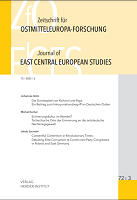Erinnerungskultur im Wandel? Tschechische Orte der Erinnerung an die antideutsche Nachkriegsgewalt
A Changing Culture of Remembrance? Czech Sites of Memory Commemorating Post-World War II Anti-German Violence
Author(s): Michal KorhelSubject(s): Political history, Social history, WW II and following years (1940 - 1949), Post-War period (1950 - 1989), Fascism, Nazism and WW II, Ethnic Minorities Studies
Published by: Verlag Herder-Institut
Keywords: Culture of rememberance; memory community; violence; Czechoslovakia; German minority; Czech society; site of memory; site of oblivion;
Summary/Abstract: In the summer of 1945, following German occupation and the atrocities committed during World War II, the German minority living in the reestablished Czechoslovak state was exposed to violent acts of retribution. Despite the state authorities’ initial endeavors to prosecute some of the acts of violence committed after the war, the Communist takeover in February 1948 rendered the post-war persecution of Germans taboo in Czechoslovakia. It was only the Velvet Revolution of 1989 that paved the way for both academic discussion and public commemoration of those tragic events. However, it was only at the turn of the millennium that the Czech society’s stance towards the post-war violence started to change. The initial taboo and resentment were partially replaced by public opinion assessing post–World War II anti-German violence more critically. Newly established sites of memory dedicated to post–World War II violence are often seen as one of the signs of a changing culture of remembrance in Czech Republic. There is, however, a lack of rigorous research exploring these monuments and plaques. The aim of this study is to analyze various aspects of these sites as part of a social framework shaping public opinion in the Czech Republic on a local level. In doing so, it seeks to answer the question of how Czech society is coming to terms with the “negatives” of its past. Drawing on oral history interviews, the paper explores the process of establishing current sites commemorating anti-German violence in today’s Czech Republic, as well as the often grass-roots initiatives that lay behind them. Furthermore, the analysis will focus on the monuments’ inscriptions and the message they send to the public, shaping its historical awareness. Understanding society as a structure consisting of various memory communities, the paper contributes to the under-researched area of a Czech culture of remembrance at a local level.
Journal: Zeitschrift für Ostmitteleuropa-Forschung
- Issue Year: 72/2023
- Issue No: 3
- Page Range: 377-409
- Page Count: 33
- Language: German

